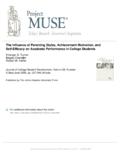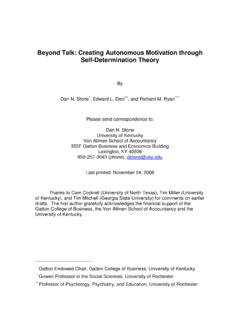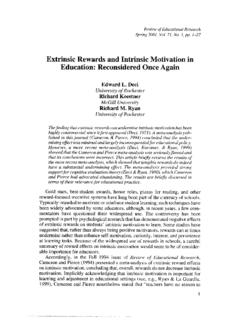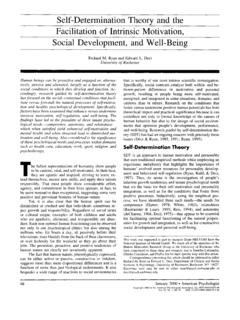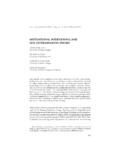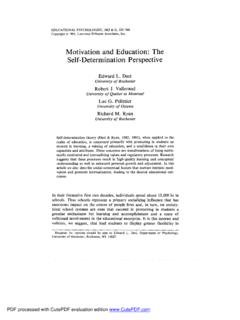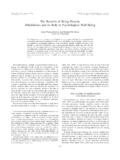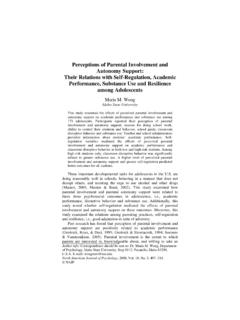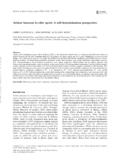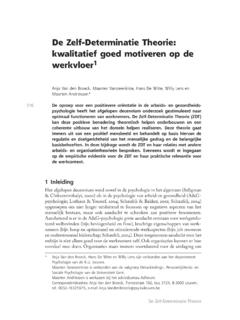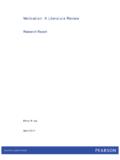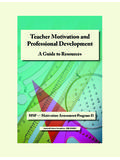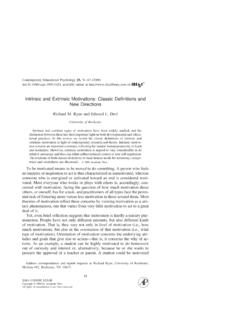Transcription of 133-144 TRE 104318 - An Approach to human motivation ...
1 [133]TRET heory and Research in EducationCopyright 2009, sage publications, 7(2) 133 144 ISSN 1477-8785 DOI: , competence, and relatedness in the classroomApplying self-determination theory to educational practicechristopher p. niemiec and richard m. ryanUniversity of Rochester, New York, USAabstractSelf-determination theory (SDT) assumes that inherent in human nature is the propensity to be curious about one s environment and interested in learning and developing one s knowledge. All too often, however, educators introduce external controls into learning climates, which can undermine the sense of relatedness between teachers and students, and stifle the natural, volitional processes involved in high-quality learning. This article presents an overview of SDT and reviews its applications to educational practice.
2 A large corpus of empirical evidence based on SDT suggests that both intrinsic motivation and autonomous types of extrinsic motivation are conducive to engagement and optimal learning in educational con texts. In addition, evidence suggests that teachers support of students basic psychological needs for autonomy, competence, and relatedness facilitates stud-ents autonomous self-regulation for learning, academic performance, and well-being. Accordingly, SDT has strong implications for both classroom practice and educational reform autonomy, education, learning, self-determination theoryInherent in human nature is the proactive tendency to engage one s physical and social surroundings and to assimilate ambient values and cultural practices. That is, people are innately curious, interested creatures who possess a natural love of learning and who desire to internalize the knowledge, cus-toms, and values that surround them.
3 These evolved tendencies to be curious at UNIV OF ROCHESTER LIBRARY on June 30, 2009 from Theory and Research in Education 7(2)[134](Lowenstein, 1994), interested (Silvia, 2008), and to seek coherence in one s knowledge (Ryan, 1995) would seem to be resources that could be cultivated and harnessed by educators as they guide learning and development. Yet too often educators introduce external controls, close supervision and monitor-ing, and evaluations accompanied by rewards or punishments into learning climates to ensure that learning occurs. Essentially, such practices reflect both external pressures on teachers (Ryan and Brown, 2005) and/or the beliefs of instructors that motivation is better shaped through external contingencies of reinforcement than by facilitating students inherent interests in learning.
4 Under such controlling conditions, however, the feelings of joy, enthusiasm, and interest that once accompanied learning are frequently replaced by experiences of anxiety, boredom, or alienation. This creates the self-fulfilling prophecy so evident in many classrooms, whereby students no longer are inter ested in what is taught, and teachers must externally control students to make learning theory (SDT; Deci and Ryan, 2000; Niemiec et al., in press; Ryan and Deci, 2000b) is a macro-theory of human motivation , emotion, and development that takes interest in factors that either facilitate or forestall the assimilative and growth-oriented processes in people. As such, SDT is of much import in the domain of education, in which students natural tendencies to learn represent perhaps the greatest resource educators can tap.
5 Yet it is also a domain in which external controls are regularly im posed, often with the well-intended belief that such contingencies promote students this article, we describe several important elements of SDT. First, we examine the concept of intrinsic motivation and those factors that sup port or undermine it in the classroom. Second, we discuss the innate tendency of people to internalize new knowledge and practices acquired through social-ization, and those factors that nurture or thwart the process of internalization. Finally, to link those two topics, we discuss students basic psychological needs for autonomy, competence, and relatedness, which when supported are associated with academic engagement and better learning outcomes, but when frustrated are associated with academic disengagement and poorer learning motivation and learningIntrinsic motivation refers to behaviors done in the absence of external impetus that are inherently interesting and enjoyable (Ryan and Deci, 2000a).
6 For example, when people are intrinsically motivated they play, explore, and engage in activities for the inherent fun, challenge, and excitement of at UNIV OF ROCHESTER LIBRARY on June 30, 2009 from Niemiec and Ryan: SDT and educational practice[135]doing so. Such behaviors have an internal perceived locus of causality (deCharms, 1968), which means they are experienced as emanating from the self rather than from external sources, and are accompanied by feelings of curiosity and interest (Deci and Ryan, 1985). Thus, as an exemplar of autonomous ( volitional) functioning, intrinsic motivation is central to humans inherent tendencies to learn and to develop (Flavell, 1999).SDT posits that intrinsic motivation is sustained by satisfaction of the basic psychological needs for autonomy and competence.
7 The need for autonomy refers to the experience of behavior as volitional and reflectively self-endorsed. For example, students are autonomous when they willingly devote time and energy to their studies. The need for competence refers to the experience of behavior as effectively enacted. For example, students are com petent when they feel able to meet the challenges of their schoolwork. Importantly, satisfaction of both autonomy and competence needs is essential to maintain intrinsic motivation , contrary to what is hypothesized by self-efficacy theory (Bandura, 1989) which denies functional significance to auton-omy. Therefore, students who feel competent, but not autonomous, will not main tain intrinsic motivation for learning. To date, dozens of experi mental studies have supported the SDT postulate that both autonomy and compet-ence are necessary conditions for the maintenance of intrinsic motivation (Deci et al.)
8 , 1999).Numerous investigators have applied the SDT framework to intrinsic motivation in educational contexts. Herein, we can only review several examples. Deci et al. (1981) assessed public elementary teachers reports of their orientations toward supporting students autonomy versus controlling their behavior. Results demonstrated that children assigned to autonomy-supportive teachers, relative to those assigned to controlling teachers, reported increased intrinsic motivation , perceived competence, and self-esteem over time. Similar findings were obtained using students perceptions of teachers autonomy support and control (Ryan and Grolnick, 1986). Benware and Deci (1984) had college students learn science material either with the expectation of teaching it to another student or with the expectation of being tested on it.
9 Results revealed that students who learned in order to teach, relative to those who learned to take a test, were more intrinsically motivated and showed better conceptual learning. In actual educational contexts in both the USA (Grolnick and Ryan, 1987) and Japan (Kage and Namiki, 1990), evaluative pressures undermined, and autonomy support facilitated, students intrinsic motivation for classroom topics and materials, as well as their performance in school. Koestner et al. (1984) conducted an in-school experiment examin-ing the effect of setting limits on behavior. Limit setting is important to educational contexts, as limits facilitate students harmonious functioning at UNIV OF ROCHESTER LIBRARY on June 30, 2009 from Theory and Research in Education 7(2)[136]within the structures of the learning environment.
10 However, teachers can set limits in different ways. Koestner et al. found that students who were given controlling limits evidenced significantly less intrinsic motivation , relative to those students given autonomy-supportive limits. Moreover, the paintings of those children given controlling limits were rated as significantly less creative than those of children who were given autonomy-supportive early findings continue to be replicated and extended in current research conducted around the globe. Tsai et al. (2008) assessed seventh grade German public school students experiences of interest in three school subjects. Multilevel modeling results showed that students interest was enhanced for lessons in which teachers were autonomy supportive, whereas students inter-est was diminished for lessons in which teachers were controlling.
